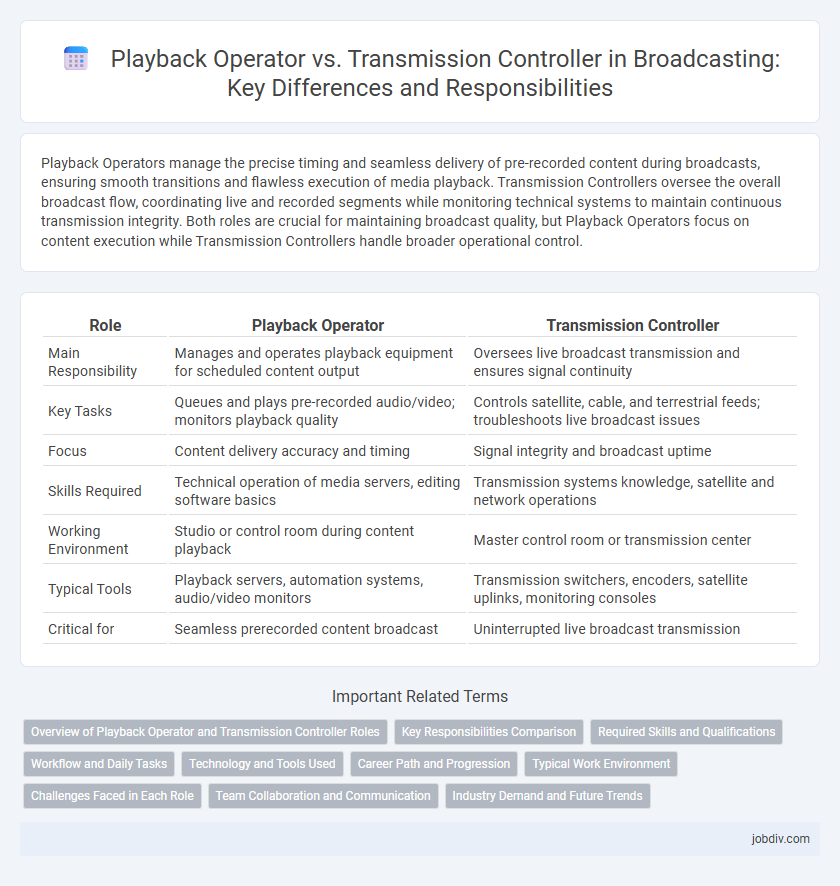Playback Operators manage the precise timing and seamless delivery of pre-recorded content during broadcasts, ensuring smooth transitions and flawless execution of media playback. Transmission Controllers oversee the overall broadcast flow, coordinating live and recorded segments while monitoring technical systems to maintain continuous transmission integrity. Both roles are crucial for maintaining broadcast quality, but Playback Operators focus on content execution while Transmission Controllers handle broader operational control.
Table of Comparison
| Role | Playback Operator | Transmission Controller |
|---|---|---|
| Main Responsibility | Manages and operates playback equipment for scheduled content output | Oversees live broadcast transmission and ensures signal continuity |
| Key Tasks | Queues and plays pre-recorded audio/video; monitors playback quality | Controls satellite, cable, and terrestrial feeds; troubleshoots live broadcast issues |
| Focus | Content delivery accuracy and timing | Signal integrity and broadcast uptime |
| Skills Required | Technical operation of media servers, editing software basics | Transmission systems knowledge, satellite and network operations |
| Working Environment | Studio or control room during content playback | Master control room or transmission center |
| Typical Tools | Playback servers, automation systems, audio/video monitors | Transmission switchers, encoders, satellite uplinks, monitoring consoles |
| Critical for | Seamless prerecorded content broadcast | Uninterrupted live broadcast transmission |
Overview of Playback Operator and Transmission Controller Roles
Playback Operators manage the precise cueing and smooth delivery of audio and video content during broadcasts, ensuring seamless program flow. Transmission Controllers oversee the entire broadcast transmission chain, monitoring technical quality, signal integrity, and compliance with broadcasting standards. Both roles are critical in maintaining uninterrupted, high-quality broadcast output and coordinating real-time responses to technical issues.
Key Responsibilities Comparison
Playback Operators manage the on-air content by queuing, previewing, and controlling video and audio playback to ensure smooth broadcast transitions. Transmission Controllers oversee the entire broadcast chain, coordinating technical operations, monitoring signal integrity, and managing distribution to multiple platforms to maintain uninterrupted transmission. Both roles are critical for seamless broadcast delivery but focus respectively on content execution and overall transmission management.
Required Skills and Qualifications
Playback Operators require proficiency in video and audio editing software, strong attention to detail, and the ability to manage media content accurately under tight deadlines. Transmission Controllers need expertise in broadcast transmission systems, real-time problem-solving skills, and knowledge of signal flow and regulatory compliance standards. Both roles demand technical acumen, teamwork, and effective communication skills to ensure seamless broadcasting operations.
Workflow and Daily Tasks
Playback Operators manage the cueing, timing, and seamless playback of pre-recorded media during broadcasts, ensuring content is delivered without interruptions. Transmission Controllers oversee the entire broadcast chain, monitoring signal quality, managing live feeds, and coordinating with technical teams to maintain broadcast integrity. Workflow for Playback Operators centers on media preparation and real-time control, while Transmission Controllers focus on system monitoring, issue resolution, and broadcast scheduling compliance.
Technology and Tools Used
Playback Operators utilize advanced broadcast automation systems such as Ross Video and Dalet Galaxy, managing pre-recorded content through video servers and playout software for seamless transmission. Transmission Controllers rely on integrated broadcast infrastructure tools like ENPS for newsroom automation and SNMP-based monitoring systems to oversee the real-time signal integrity and satellite uplink status. Both roles leverage IP-based routing technologies and multi-viewer displays to ensure precise content delivery and live broadcast continuity.
Career Path and Progression
Playback Operators specialize in managing and cuing video content during live broadcasts, developing technical skills with broadcast equipment and software. Transmission Controllers oversee the entire broadcast flow, ensuring seamless transmission and coordinating between departments, which requires broader operational knowledge and leadership abilities. Career progression often leads Playback Operators to move into Transmission Controller roles, leveraging their hands-on experience for greater responsibility and managerial opportunities.
Typical Work Environment
Playback Operators typically work in broadcast studios or production control rooms where they manage audio and video playback equipment during live or recorded shows. Transmission Controllers operate in transmission centers, ensuring seamless broadcast signal distribution and coordinating with satellite or fiber networks. Both roles often require working under high pressure with tight deadlines to maintain uninterrupted broadcast transmission.
Challenges Faced in Each Role
Playback Operators confront challenges including precise cueing of media content and managing technical glitches during live broadcasts to prevent on-air errors. Transmission Controllers face the complexity of coordinating multiple broadcast feeds while ensuring seamless signal integrity and compliance with regulatory standards. Both roles demand quick decision-making under pressure to maintain uninterrupted and high-quality broadcast delivery.
Team Collaboration and Communication
Playback Operators and Transmission Controllers must maintain seamless communication to ensure flawless broadcast delivery and real-time issue resolution. Collaborative efforts between these roles optimize timing, content synchronization, and adherence to broadcast schedules, minimizing on-air errors. Effective teamwork enhances the overall broadcast workflow, improving live transmission reliability and audience experience.
Industry Demand and Future Trends
Playback Operators remain essential for managing live content playback and real-time editing in broadcasting environments, driven by the growing demand for seamless live event production. Transmission Controllers focus on signal integrity and broadcast transmission continuity, with industry trends shifting towards automation and AI-enhanced monitoring to reduce human error. Future industry demand highlights a convergence of these roles, emphasizing cross-skilled professionals adept in both content playback and transmission technologies.
Playback Operator vs Transmission Controller Infographic

 jobdiv.com
jobdiv.com